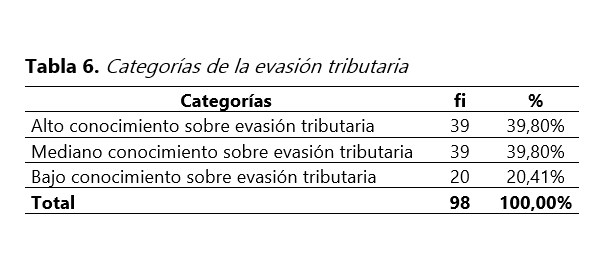Evasión Tributaria en el Centro Comercial Mercado Modelo de San Ramón
DOI:
https://doi.org/10.56926/unaaaciencia.v2i1.37Palabras clave:
conciencia tributaria, función de fiscalización, orientación tributaria, obligación de formalizaciónResumen
La evasión tributaria en el Perú plantea un problema persistente que socava el sistema fiscal y limita los recursos disponibles para el desarrollo y bienestar de la sociedad. El objetivo del presente estudio fue identificar el nivel de conocimiento de evasión tributaria de los comerciantes en el Centro Comercial Mercado Modelo, San Ramón en el año 2019. La investigación se enmarcó como enfoque cuantitativo y por finalidad del tipo aplicada. El método general empleado fue científico y como métodos específicos: descriptivo, teórico y estadístico. El diseño fue descriptivo simple, el cual en base a una muestra se realizó la observación y recolección de datos, de corte transversal, dado que nuestra pesquisa se basó en un tiempo específico. Se utilizó la encuesta a modo de técnica y el cuestionario como instrumento. Según el análisis de resultados se identificó una moderada evasión tributaria, evidenciado por el 39,80% de opiniones de los encuestados, similar a quienes manifestaron alta evasión. También demostraron regular conocimiento sobre tributación y el fin que tiene la recaudación, así como la información que necesitan los contribuyentes que no está siendo del todo ejecutada, ya que aún hay encuestados con falta de orientación, evidenciado por el 20.41% de la muestra.
Descargas
Citas
Alva Matteucci, M. (2018). Pautas para entender la teoría de los juegos y la evasión tributaria. Blog de Mario Alva Matteucci. http://blog.pucp.edu.pe/blog/blogdemarioalva/2018/12/14/pautas-para-entender-la-teoria-de-los-juegos-y-la-evasion-tributaria/
Cabrera Sánchez, M., Sánchez-Chero, M., Cachay Sánchez, L., & Rosas-Prado, C. (2021). Cultura tributaria y su relación con la evasión fiscal en Perú. Revista de Ciencias Sociales, 27, 204–218. https://doi.org/10.31876/rcs.v27i.36503 DOI: https://doi.org/10.31876/rcs.v27i.36503
e Hassan, I., Naeem, A., & Gulzar, S. (2021). Voluntary tax compliance behavior of individual taxpayers in Pakistan. Financial Innovation, 7(1), 21. https://doi.org/10.1186/s40854-021-00234-4 DOI: https://doi.org/10.1186/s40854-021-00234-4
Mindiola Perez, G., & Cárdenas Ramirez, E. (2014). Factores que inciden en la evasión del impuesto de industria y comercio por parte de los comerciantes del municipio de Ocaña [Universidad Francisco de Paula Santander]. http://repositorio.ufpso.edu.co/handle/123456789/1196
Núñez Sánchez, A. E. (2015). Determinantes económicos en la recaudación fiscal de las pymes de la provincia de Santa Elena [Universidad de Guayaquil]. http://repositorio.ug.edu.ec/handle/redug/8967
Pérez Maldacena, J. I. (2022). Las empresas Fintech y su influencia en la inclusión financiera en Argentina [Universidad de San Andrés]. http://hdl.handle.net/10908/19225
Quincho Rojas, T. G. (2021). El impacto de la recesión económica ocasionado por la pandemia de covid-19 en la inclusión financiera del Perú. Visionarios En Ciencia y Tecnología, 6(S1), 126–166. https://doi.org/10.47186/visct.v6iS1.79 DOI: https://doi.org/10.47186/visct.v6iS1.79
Suclle Puma, R. (2017). Conciencia tributaria y evasión tributaria en los comerciantes de abarrotes del distrito de Laberinto, Madre de Dios, 2016 [Universidad Andina del Cusco]. https://hdl.handle.net/20.500.12557/1105
Vara Morales, D. (2018). Evasión tributaria del nuevo régimen único simplificado y la recaudación fiscal en los comerciantes del Mercado Modelo de Hánuco, 2018 [Universidad de Huánuco]. http://repositorio.udh.edu.pe/123456789/1266

Publicado
Cómo citar
Número
Sección
Licencia
Derechos de autor 2023 Keyla Alessandra Villon-Sedano, Darlynthon Kevin Vilcapoma-Venturo, Richard Zegarra-Estrada

Esta obra está bajo una licencia internacional Creative Commons Atribución 4.0.
Los autores retienen sus derechos:
a. Los autores retienen sus derechos de marca y patente, y también sobre cualquier proceso o procedimiento descrito en el artículo.
b. Los autores retienen el derecho de compartir, copiar, distribuir, ejecutar y comunicar públicamente el articulo publicado en la revista científica UNAAACIENCIA-PERÚ (por ejemplo, colocarlo en un repositorio institucional o publicarlo en un libro), con un reconocimiento de su publicación inicial en la UNAAACIENCIA-PERÚ.
c. Los autores retienen el derecho a hacer una posterior publicación de su trabajo, de utilizar el artículo o cualquier parte de aquel (por ejemplo: una compilación de sus trabajos, notas para conferencias, tesis, o para un libro), siempre que indiquen la fuente de publicación (autores del trabajo, revista, volumen, numero y fecha).







